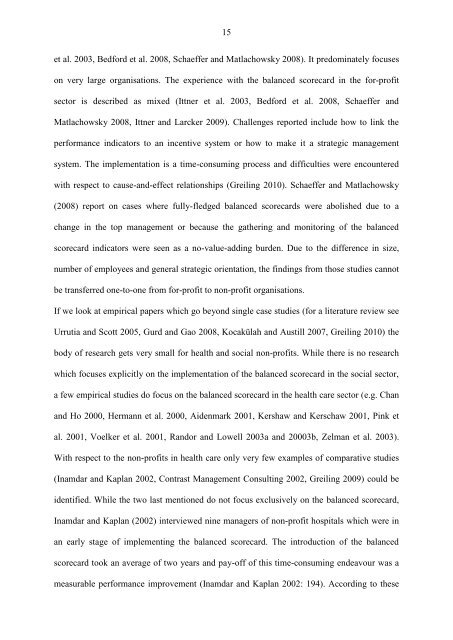Strategic responses to Performance Measurement in Nonprofit ...
Strategic responses to Performance Measurement in Nonprofit ...
Strategic responses to Performance Measurement in Nonprofit ...
Create successful ePaper yourself
Turn your PDF publications into a flip-book with our unique Google optimized e-Paper software.
15<br />
et al. 2003, Bedford et al. 2008, Schaeffer and Matlachowsky 2008). It predom<strong>in</strong>ately focuses<br />
on very large organisations. The experience with the balanced scorecard <strong>in</strong> the for-profit<br />
sec<strong>to</strong>r is described as mixed (Ittner et al. 2003, Bedford et al. 2008, Schaeffer and<br />
Matlachowsky 2008, Ittner and Larcker 2009). Challenges reported <strong>in</strong>clude how <strong>to</strong> l<strong>in</strong>k the<br />
performance <strong>in</strong>dica<strong>to</strong>rs <strong>to</strong> an <strong>in</strong>centive system or how <strong>to</strong> make it a strategic management<br />
system. The implementation is a time-consum<strong>in</strong>g process and difficulties were encountered<br />
with respect <strong>to</strong> cause-and-effect relationships (Greil<strong>in</strong>g 2010). Schaeffer and Matlachowsky<br />
(2008) report on cases where fully-fledged balanced scorecards were abolished due <strong>to</strong> a<br />
change <strong>in</strong> the <strong>to</strong>p management or because the gather<strong>in</strong>g and moni<strong>to</strong>r<strong>in</strong>g of the balanced<br />
scorecard <strong>in</strong>dica<strong>to</strong>rs were seen as a no-value-add<strong>in</strong>g burden. Due <strong>to</strong> the difference <strong>in</strong> size,<br />
number of employees and general strategic orientation, the f<strong>in</strong>d<strong>in</strong>gs from those studies cannot<br />
be transferred one-<strong>to</strong>-one from for-profit <strong>to</strong> non-profit organisations.<br />
If we look at empirical papers which go beyond s<strong>in</strong>gle case studies (for a literature review see<br />
Urrutia and Scott 2005, Gurd and Gao 2008, Kocakülah and Austill 2007, Greil<strong>in</strong>g 2010) the<br />
body of research gets very small for health and social non-profits. While there is no research<br />
which focuses explicitly on the implementation of the balanced scorecard <strong>in</strong> the social sec<strong>to</strong>r,<br />
a few empirical studies do focus on the balanced scorecard <strong>in</strong> the health care sec<strong>to</strong>r (e.g. Chan<br />
and Ho 2000, Hermann et al. 2000, Aidenmark 2001, Kershaw and Kerschaw 2001, P<strong>in</strong>k et<br />
al. 2001, Voelker et al. 2001, Randor and Lowell 2003a and 20003b, Zelman et al. 2003).<br />
With respect <strong>to</strong> the non-profits <strong>in</strong> health care only very few examples of comparative studies<br />
(Inamdar and Kaplan 2002, Contrast Management Consult<strong>in</strong>g 2002, Greil<strong>in</strong>g 2009) could be<br />
identified. While the two last mentioned do not focus exclusively on the balanced scorecard,<br />
Inamdar and Kaplan (2002) <strong>in</strong>terviewed n<strong>in</strong>e managers of non-profit hospitals which were <strong>in</strong><br />
an early stage of implement<strong>in</strong>g the balanced scorecard. The <strong>in</strong>troduction of the balanced<br />
scorecard <strong>to</strong>ok an average of two years and pay-off of this time-consum<strong>in</strong>g endeavour was a<br />
measurable performance improvement (Inamdar and Kaplan 2002: 194). Accord<strong>in</strong>g <strong>to</strong> these
















